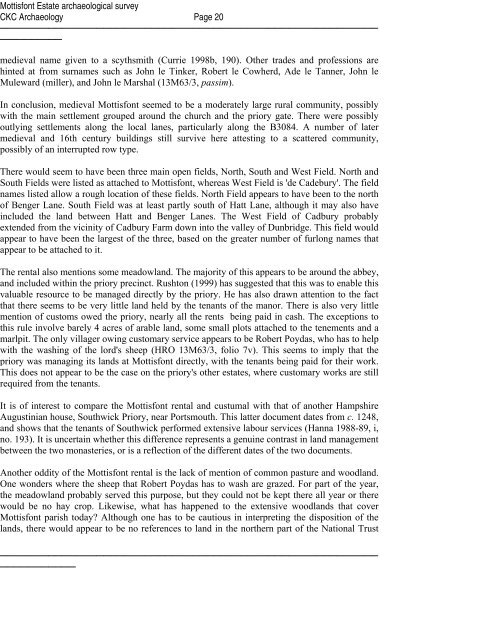An archaeological and historical - Archaeology Data Service
An archaeological and historical - Archaeology Data Service
An archaeological and historical - Archaeology Data Service
You also want an ePaper? Increase the reach of your titles
YUMPU automatically turns print PDFs into web optimized ePapers that Google loves.
Mottisfont Estate <strong>archaeological</strong> survey<br />
CKC <strong>Archaeology</strong> Page 20<br />
───────────────────────────────────────────────────────<br />
─────────<br />
medieval name given to a scythsmith (Currie 1998b, 190). Other trades <strong>and</strong> professions are<br />
hinted at from surnames such as John le Tinker, Robert le Cowherd, Ade le Tanner, John le<br />
Muleward (miller), <strong>and</strong> John le Marshal (13M63/3, passim).<br />
In conclusion, medieval Mottisfont seemed to be a moderately large rural community, possibly<br />
with the main settlement grouped around the church <strong>and</strong> the priory gate. There were possibly<br />
outlying settlements along the local lanes, particularly along the B3084. A number of later<br />
medieval <strong>and</strong> 16th century buildings still survive here attesting to a scattered community,<br />
possibly of an interrupted row type.<br />
There would seem to have been three main open fields, North, South <strong>and</strong> West Field. North <strong>and</strong><br />
South Fields were listed as attached to Mottisfont, whereas West Field is 'de Cadebury'. The field<br />
names listed allow a rough location of these fields. North Field appears to have been to the north<br />
of Benger Lane. South Field was at least partly south of Hatt Lane, although it may also have<br />
included the l<strong>and</strong> between Hatt <strong>and</strong> Benger Lanes. The West Field of Cadbury probably<br />
extended from the vicinity of Cadbury Farm down into the valley of Dunbridge. This field would<br />
appear to have been the largest of the three, based on the greater number of furlong names that<br />
appear to be attached to it.<br />
The rental also mentions some meadowl<strong>and</strong>. The majority of this appears to be around the abbey,<br />
<strong>and</strong> included within the priory precinct. Rushton (1999) has suggested that this was to enable this<br />
valuable resource to be managed directly by the priory. He has also drawn attention to the fact<br />
that there seems to be very little l<strong>and</strong> held by the tenants of the manor. There is also very little<br />
mention of customs owed the priory, nearly all the rents being paid in cash. The exceptions to<br />
this rule involve barely 4 acres of arable l<strong>and</strong>, some small plots attached to the tenements <strong>and</strong> a<br />
marlpit. The only villager owing customary service appears to be Robert Poydas, who has to help<br />
with the washing of the lord's sheep (HRO 13M63/3, folio 7v). This seems to imply that the<br />
priory was managing its l<strong>and</strong>s at Mottisfont directly, with the tenants being paid for their work.<br />
This does not appear to be the case on the priory's other estates, where customary works are still<br />
required from the tenants.<br />
It is of interest to compare the Mottisfont rental <strong>and</strong> custumal with that of another Hampshire<br />
Augustinian house, Southwick Priory, near Portsmouth. This latter document dates from c. 1248,<br />
nd shows that the tenants of Southwick performed extensive labour services (Hanna 1988-89, i,<br />
o. 193). It is uncertain whether this difference represents a genuine contrast in l<strong>and</strong> management<br />
etween the two monasteries, or is a reflection of the different dates of the two documents.<br />
<strong>An</strong>other oddity of the Mottisfont rental is the lack of mention of common pasture <strong>and</strong> woodl<strong>and</strong>.<br />
One wonders where the sheep that Robert Poydas has to wash are grazed. For part of the year,<br />
the meadowl<strong>and</strong> probably served this purpose, but they could not be kept there all year or there<br />
would be no hay crop. Likewise, what has happened to the extensive woodl<strong>and</strong>s that cover<br />
Mottisfont parish today? Although one has to be cautious in interpreting the disposition of the<br />
l<strong>and</strong>s, there would appear to be no references to l<strong>and</strong> in the northern part of the National Trust<br />
───────────────────────────────────────────────────────<br />
───────────

















